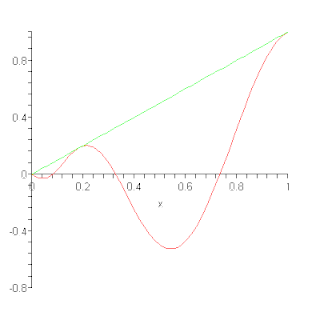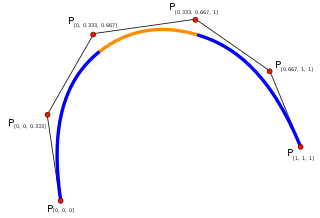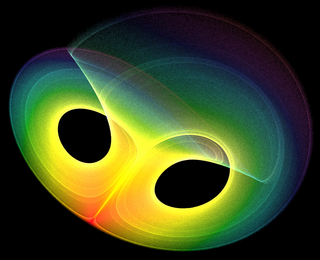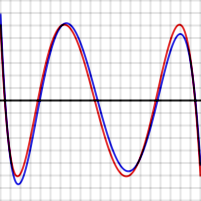In mathematics, a transcendental number is a real number or complex number that is not an algebraic number—that is, not a root of a nonzero polynomial equation with integer coefficients. The best-known transcendental numbers are π and e.
The fundamental theorem of algebra states that every non-constant single-variable polynomial with complex coefficients has at least one complex root. This includes polynomials with real coefficients, since every real number is a complex number with an imaginary part equal to zero.

In calculus, Taylor's theorem gives an approximation of a k-times differentiable function around a given point by a k-th order Taylor polynomial. For analytic functions the Taylor polynomials at a given point are finite-order truncations of its Taylor series, which completely determines the function in some neighborhood of the point. It can be thought of as the extension of linear approximation to higher order polynomials, and in the case of k equals 2 is often referred to as a quadratic approximation. The exact content of "Taylor's theorem" is not universally agreed upon. Indeed, there are several versions of it applicable in different situations, and some of them contain explicit estimates on the approximation error of the function by its Taylor polynomial.

In the mathematical field of numerical analysis, Runge's phenomenon is a problem of oscillation at the edges of an interval that occurs when using polynomial interpolation with polynomials of high degree over a set of equispaced interpolation points. It was discovered by Carl David Tolmé Runge (1901) when exploring the behavior of errors when using polynomial interpolation to approximate certain functions. The discovery was important because it shows that going to higher degrees does not always improve accuracy. The phenomenon is similar to the Gibbs phenomenon in Fourier series approximations.

In the mathematical field of numerical analysis, a Bernstein polynomial, named after Sergei Natanovich Bernstein, is a polynomial in the Bernstein form, that is a linear combination of Bernstein basis polynomials.

In mathematics, a spline is a function defined piecewise by polynomials. In interpolating problems, spline interpolation is often preferred to polynomial interpolation because it yields similar results, even when using low degree polynomials, while avoiding Runge's phenomenon for higher degrees.
In mathematics, the Mahler measureof a polynomial with complex coefficients is defined as
In mathematics, the Lebesgue constants give an idea of how good the interpolant of a function is in comparison with the best polynomial approximation of the function. The Lebesgue constant for polynomials of degree at most n and for the set of n + 1 nodes T is generally denoted by Λn(T ). These constants are named after Henri Lebesgue.
In numerical analysis, the Durand–Kerner method, discovered by Karl Weierstrass in 1891 and rediscovered independently by Durand in 1960 and Kerner in 1966, is a root-finding algorithm for solving polynomial equations. In other words, the method can be used to solve numerically the equation
In additive number theory and combinatorics, a restricted sumset has the form
In mathematics, a univariate polynomial of degree n with real or complex coefficients has n complex roots, if counted with their multiplicities. They form a set of n points in the complex plane. This article concerns the geometry of these points, that is the information about their localization in the complex plane that can be deduced from the degree and the coefficients of the polynomial.
In mathematics, the Markov brothers' inequality is an inequality proved in the 1890s by brothers Andrey Markov and Vladimir Markov, two Russian mathematicians. This inequality bounds the maximum of the derivatives of a polynomial on an interval in terms of the maximum of the polynomial. For k = 1 it was proved by Andrey Markov, and for k = 2,3,... by his brother Vladimir Markov.
In approximation theory, Jackson's inequality is an inequality bounding the value of function's best approximation by algebraic or trigonometric polynomials in terms of the modulus of continuity or modulus of smoothness of the function or of its derivatives. Informally speaking, the smoother the function is, the better it can be approximated by polynomials.
In mathematics, the height and length of a polynomial P with complex coefficients are measures of its "size".
In mathematics, particularly numerical analysis, the Bramble–Hilbert lemma, named after James H. Bramble and Stephen Hilbert, bounds the error of an approximation of a function by a polynomial of order at most in terms of derivatives of of order . Both the error of the approximation and the derivatives of are measured by norms on a bounded domain in . This is similar to classical numerical analysis, where, for example, the error of linear interpolation can be bounded using the second derivative of . However, the Bramble–Hilbert lemma applies in any number of dimensions, not just one dimension, and the approximation error and the derivatives of are measured by more general norms involving averages, not just the maximum norm.
In functional analysis, a discipline within mathematics, the Szász–Mirakyan operators are generalizations of Bernstein polynomials to infinite intervals, introduced by Otto Szász in 1950 and G. M. Mirakjan in 1941. They are defined by
In mathematical analysis, constructive function theory is a field which studies the connection between the smoothness of a function and its degree of approximation. It is closely related to approximation theory. The term was coined by Sergei Bernstein.
In mathematics, the Grunsky matrices, or Grunsky operators, are matrices introduced by Grunsky (1939) in complex analysis and geometric function theory. They correspond to either a single holomorphic function on the unit disk or a pair of holomorphic functions on the unit disk and its complement. The Grunsky inequalities express boundedness properties of these matrices, which in general are contraction operators or in important special cases unitary operators. As Grunsky showed, these inequalities hold if and only if the holomorphic function is univalent. The inequalities are equivalent to the inequalities of Goluzin, discovered in 1947. Roughly speaking, the Grunsky inequalities give information on the coefficients of the logarithm of a univalent function; later generalizations by Milin, starting from the Lebedev–Milin inequality, succeeded in exponentiating the inequalities to obtain inequalities for the coefficients of the univalent function itself. Historically the inequalities were used in proving special cases of the Bieberbach conjecture up to the sixth coefficient; the exponentiated inequalities of Milin were used by de Branges in the final solution. The Grunsky operators and their Fredholm determinants are related to spectral properties of bounded domains in the complex plane. The operators have further applications in conformal mapping, Teichmüller theory and conformal field theory.
Bernstein's theorem is an inequality relating the maximum modulus of a complex polynomial function on the unit disk with the maximum modulus of its derivative on the unit disk. It was proven by Sergei Bernstein while he was working on approximation theory.

An International Standard Serial Number (ISSN) is an eight-digit serial number used to uniquely identify a serial publication, such as a magazine. The ISSN is especially helpful in distinguishing between serials with the same title. ISSN are used in ordering, cataloging, interlibrary loans, and other practices in connection with serial literature.
zbMATH, formerly Zentralblatt MATH, is a major international reviewing service providing reviews and abstracts for articles in pure and applied mathematics, produced by the Berlin office of FIZ Karlsruhe – Leibniz Institute for Information Infrastructure GmbH. Editors are the European Mathematical Society (EMS), FIZ Karlsruhe, and the Heidelberg Academy of Sciences. zbMATH is distributed by Springer Science+Business Media. It uses the Mathematics Subject Classification codes for organising the reviews by topic.
Isidor Pavlovich Natanson was a Swiss-born Soviet mathematician known for contributions to real analysis and constructive function theory, in particular, for his textbooks on these subjects. His son, Garal'd Natanson (1930–2003), was also a known mathematician.











